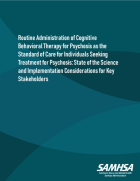This report provides key findings from the 2022 National Survey on Drug Use and Health (NSDUH) on substance use, mental health, and treatment among the noninstitutionalized U.S. population aged 12 or older. Estimates are presented by age group and by race/ethnicity for selected measures.
Dashboard: Filter Bricks
Main page content


Read key findings from the 2021 National Survey on Drug Use and Health (NSDUH) on substance use, mental health, and treatment. Metrics in the report cover the civilian, noninstitutionalized US population ages 12 and older. Estimates are presented by age group and by race/ethnicity for selected measures. Unlike other NSDUH Annual National Reports, the 2021 report has no discussion of trends over time, because changes in survey methodology mean the indicators are not comparable to past NSDUH estimates.

This document provides an overview of essential information necessary for understanding mental health and substance use disorder parity and how to implement and comply with federal parity laws. This guide applies to parity laws in employer-sponsored health plans and group and individual insurance.

This guide provides mental health decision-makers (e.g., state/local mental health directors, treatment facility clinical directors, and other stakeholders) with rationale and evidence to support wide-spread expansion of Cognitive Behavioral Therapy for Psychosis (CBTp) across mental health systems.

This chartbook uses combined 2015 to 2019 data from the National Survey on Drug Use and Health (NSDUH) to present nationally representative estimates of substance use, substance use disorders, and substance use treatment utilization among people aged 12 or older within different racial/ethnic groups in the United States. The percentages are annual averages.

This guide helps local systems use data to implement Crisis Intervention Team programs that can improve the safety and effectiveness of law enforcement response to people experiencing behavioral health crises. It provides information about building necessary partnerships, documenting program activities, identifying key metrics, establishing data collection processes, analyzing and reporting data, using data to improve programs, and expanding capacity to collect and use data. The guide is a companion to Practice Guidelines: Core Elements in Responding to Mental Health Crises.

This handbook outlines key roles and responsibilities and explains procedures for post-award activities, changes, and the continuation application processes. It also includes helpful reference materials such as an acronym chart, a glossary, and helpful Web links.

This report shines the spotlight on the critical issues and services for Americans with serious mental illnesses (SMI) and serious emotional disturbances (SED), and the importance of concerted efforts by the federal government to address their needs. The report presents the current status of federal activities and a summary of advances in the care and treatment of people with SMI and SED. The report describes key advances in research and strategies to improve services to these individuals based on presentations given by the Interdepartmental Serious Mental Illness Coordinating Committee (ISMICC) members at the first ISMICC meeting.

This Executive Summary to the 2017 report to Congress shines the spotlight on the critical issues and services for Americans with serious mental illnesses (SMI) and serious emotional disturbances (SED). The 2017 report to congress represents the starting point in a five-year process of improving the lives of people with SMI and SED. This 8-page summary delineates the five focus areas, each with 8-10 recommendations. These recommendations are from the non-federal members and represent common areas in which federal partners and stakeholders can work together to implement over the next five years.

This report highlights the structure, responsibilities, policies, services, and financing of single-state agencies and state mental health agencies. The report includes discussion of efforts to integrate physical and behavioral health and efforts by state agencies to address opioid abuse and misuse.
Displaying 1 - 10 out of 28

